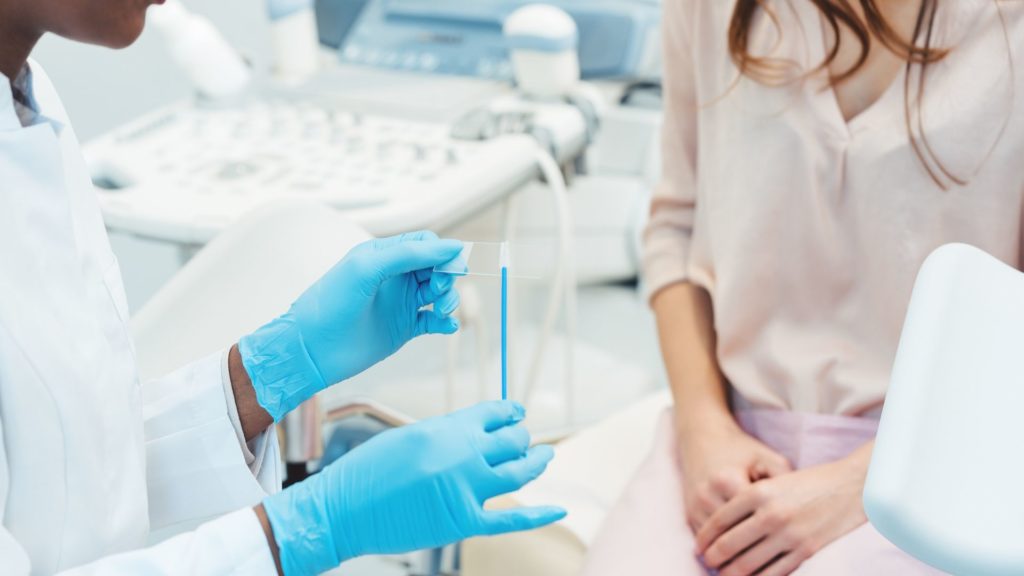Chancroid occurs continuously in some areas of the United States and in discrete outbreaks in other areas. Chancroid is usually present for HIV transmission to occur. High rates of HIV infection among patients who have chancroid have been reported in the United States and other countries. An estimated 10% of patients who have chancroid could also be infected with T. pallidum or herpes simplex virus (HSV).
A probable diagnosis, for both clinical and surveillance purposes, may be made if the following criteria are met: a) the patient has one or more painful genital ulcers; b) the patient has no evidence of T. pallidum infection by darkfield examination of ulcer exudate or by a serologic test for syphilis performed at least 7 days after onset of ulcers; and c) the clinical presentation, appearance of genital ulcers, and regional lymphadenopathy, if present, are typical for chancroid and a test for HSV is negative. The combination of a painful ulcer and tender inguinal adenopathy, which occurs among one third of patients, suggests a diagnosis of chancroid; when accompanied by suppurative inguinal adenopathy, these signs are almost pathognomonic.
Treatment
Successful treatment for chancroid cures the infection, resolves the clinical symptoms, and prevents transmission to others. In extensive cases, scarring can result despite successful therapy.
Recommended Regimens
Azithromycin 1 g orally in a single dose,
OR
Ceftriaxone 250 mg intramuscularly (IM) in a single dose,
OR
Ciprofloxacin 500 mg orally twice a day for 3 days,
OR
Erythromycin base 500 mg orally four times a day for 7 days.
NOTE: Ciprofloxacin should not be used for pregnant and lactating women or for persons less than 18 years of age.
All four regimens are effective for treatment of chancroid in HIV-infected patients. Azithromycin and ceftriaxone offer the advantage of single-dose therapy.
Follow-Up
Patients should be re-examined 3 to 7 days after initiation of therapy. If treatment is successful, ulcers improve symptomatically within 3 days and objectively within 7 days after therapy. If no clinical improvement is evident, the clinician must consider whether a) the diagnosis is correct, b) the patient is coinfected with another STD, c) the patient is infected with HIV, d) the treatment was not taken as instructed, or e) the H. ducreyi strain causing the infection is resistant to the prescribed antimicrobial. The time required for complete healing depends on the size of the ulcer; large ulcers may require greater than 2 weeks. In addition, healing is slower for some uncircumcised men who have ulcers under the foreskin. Clinical resolution of fluctuant lymphadenopathy is slower than that of ulcers and may require drainage, even during otherwise successful therapy. Although needle aspiration of buboes is a simpler procedure, incision and drainage of buboes may be preferred because of less need for subsequent drainage procedures.
Management of Sex Partners
Sex partners of patients who have chancroid should be examined and treated, regardless of whether symptoms of the disease are present, if they had sexual contact with the patient during the 10 days preceding onset of symptoms in the patient.
Special Considerations:
- Pregnancy: The safety of azithromycin for pregnant and lactating women has not been established. Ciprofloxacin is contraindicated during pregnancy. No adverse effects of chancroid on pregnancy outcome or on the fetus have been reported.
Thomas G. Stovall, M.D.
Dr. Stovall is a Clinical Professor of Obstetrics and Gynecology at the University of Tennessee Health Science Center in Memphis, Tennessee and Partner of Women’s Health Specialists, Inc.

